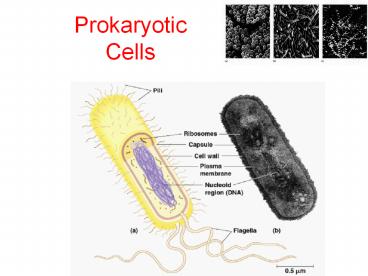Prokaryotic Cells PowerPoint PPT Presentation
1 / 48
Title: Prokaryotic Cells
1
Prokaryotic Cells
2
Kingdom Protista
3
Kingdom Protista
- Eukaryotic
- Mostly unicellular
- A very heterogeneous group include both
heterotrophic and photoautotrophic forms - 11 phyla
- Lots of disagreements
- Whittaker leftovers
4
Reproduction
- binary fission splits into two asexually
- multiple fission producing more than two
individuals - sexually by conjugation (opposite mating strains
join exchange genetic material)
5
Kingdom Protista
3 informal groups Animal-like protists Fungus-like
protists Plant-like (algal) protists Misleading
some change
45,000 species
6
Animal-like Protists
Amoeba Cilliates Flagellates
13,000 species
7
Animal-like Protists
- Classified by the way they move
pseudopodia
cilia
flagella
8
- Heterotrophs ingest small food particles digest
it inside food vacuoles containing digestive
enzymes
9
Animal-like protists
- Sarcomastigophora (amoebas, forams, radiolarian)
- Ciliophora (paramecium)
- Zoomastigophora (trypansoma)
- Apicocomplexa (Sporozoa)
10
Animal-like Protists
Phylum Sarcomastigophora Amoeba Shell-like
glass or calcium carbonate structures Radiating
projections
13,000 species
11
Note glass projections
12
Foraminifera
Tropics beaches Most have symbiotic algae
13
ForameniferaGlobigerina ooze
Covers about 36of the ocean floor
14
Animal-like Protists
Phylum Ciliophora (ciliates) Largest, most
homogeneous Share few characteristicswith
others Movement coordinated Sex 8 mating types
8,000 species
15
Paramecium
16
(No Transcript)
17
Animal-like Protists
- Phylum Zoomastigophora (zooflagellates)
- Move using flagella1 to thousands of flagella
- Some parasites
- African trypanosomiasis sleeping sickness
tsetse fly - Chagas Disease kissing bug
- Leishmaniasis sand fly
- giardiasis
- Vaccines? change protein coat!
- Gave rise to animals?
1,500 species
18
African sleeping sickness
Tsetse fly
Trypansoma
19
The Kissing Bug
Chagas disease
20
Leishmaniasis
Sand fly
Leishmania
21
Malaria
Mosquito victim Africa kills 1 million
children per year Thousands of sporozoites
injected Vaccine? (US support?)
Anopheles Mosquito
gameteocyte
Plasmodium sporozoite
22
Fungus-like Protists
475 species
Phylum Oomycota(water molds mildew,
blights) Some unicellular others consist of
hyphae Decomposers,parasites Cell walls-
cellulose Related to algae based on cell wall
composition Named after reproductive method
No septa
23
water molds
24
Downy Mildew
25
Mildew hyphae
26
Fungus-like Protists
Phylum Myxomycota(slime molds) Bizarre Bright
colors Moving slime mass Acellular body
550 species
27
Fungus-like Protists
Mildew Water molds Blights
Downey mildew
475 species
Slime molds
28
(No Transcript)
29
(No Transcript)
30
Slime Mold Maze
The slime mold starts out evenly spread through
the maze, but when food sources are placed at two
ends, the slime mold retracts from everywhere but
the shortest path.
31
Diatoms
Plant-like Protists
- Dinoflagellates
- Diatoms
- Euglena
- Cocolithophore
- Green algae
- Brown Algae
- Red algae
Dinoflagellates
Cocolithophore
Radiolarian
32
Plant-like Protists
Phylum Pyrrophyta (dinoflagellates)
Marine and Freshwater
Some live in corals
Cause red tide
1,100 species
33
Zooxanthellae in Coral Polyp
34
Bioluminescence
Pyrocystis fusiformis
35
Red Tide
HAB (harmful algal blooms) can result in PSP
(paraletic shellfish poisoning)
Gonyaulax polyhedra, Gymnodium
36
Red Tide
37
Plant-like Protists
Phylum Chrysophyta (diatoms golden
algae) Link to green algae
13,000 species
38
HAB- diatoms
2009 Washington State 10,000 seabirds deaths
Alfred Hitchkock The Birds
Diatom - Akashiwo sanguinea Domoic acid
39
Plant-like Protists
Phylum Euglenophyta (euglenoids)
800 species
40
Division Chlorophyta
Green algae Most freshwater or terrestrial Some
marine
7,000 species
41
Chlorophyta Green Algae
Codium edule
Caulerpa sertularioides
Dictyosphaeria cavernosa
Caulerpa racemosa
42
Division Phaeophyta
Brown algae Marine habitats Example giant
kelp forests
1,500 species
43
- Example of complex morphology Macrocystis
- holdfast - attaches to substrate
- stipe
- blade - main organ of photosynthesis
- bladder - keeps blades near the surface
Blade
Bladder
Stipe
Holdfast
44
(No Transcript)
45
(No Transcript)
46
Phaeophyta Brown Algae
Hydroclathrus clathratus
Sargassum echinocarpum
Sargassum polyphyllum
47
Division Rhodophyta
Red algae Most in marine habitats
4,000 species
48
Rhodophyta Red Algae
Asparagopsis taxiformis

